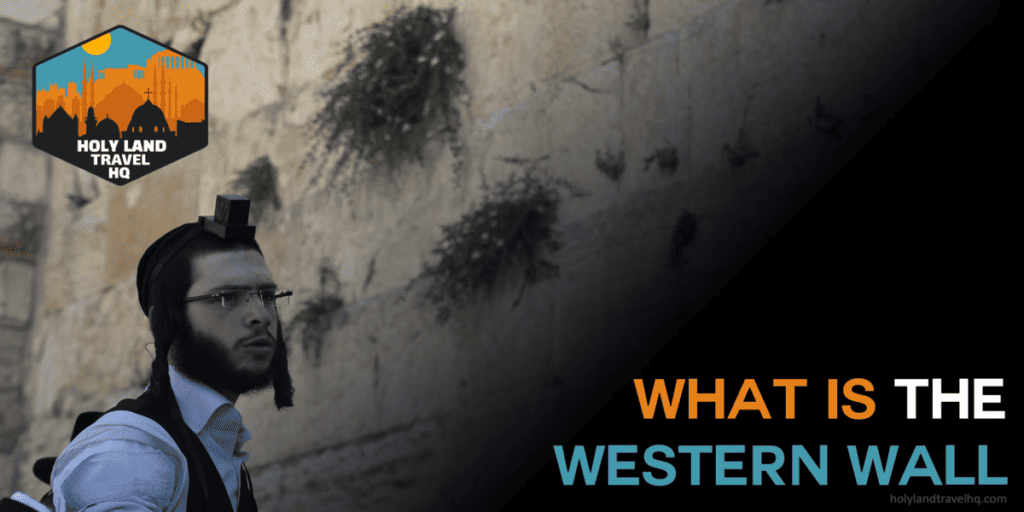
The Temple Mount in Jerusalem is one of the most recognizable religious sites in the world today. If not the most. It spans over 1,500 feet in length and around 1,000 feet in width. While Muslims flood the platform on top to pray, Jews flock to the Western Wall.
We’ll get to the Dome of the Rock and the top of the Temple Mount in a later post. Today, let’s talk about the Western Wall.
The Western Wall, or Kotel in Hebrew, is a section of the retaining wall on the western side of the Temple Mount in Jerusalem. Most of the western retaining wall is underground. The 190-foot section that is visible and accessible is what we know today as the Western Wall. It is the closest point that Jews can get to the location where the Hebrew Temple once stood.
Any discussion about the Western Wall will always include a discussion about the temple and the Temple Mount. The Western Wall can’t be what it is today, without recognition of it’s larger history.
Note: All links are direct. All verses are linked to biblegateway.com.
Why was the Hebrew Temple constructed in the first place?
In Exodus 26 God gave Moses directions on how to build the Tabernacle, a tent specifically designed for worship. He provided dimensions, what materials were to be used, and a layout. Specific rules were given on its use. The reason for all this was that it was God’s dwelling place among His people.
As the Israelites wandered the desert living in tents, God joined them. When the Israelites entered the Promised Land, the Tabernacle ended up in Shiloh. During Saul’s reign, it was first moved to Nob. After getting angry with the priests and killing them all, Saul moved the tabernacle to a city north of Jerusalem named Gibeon.
When David took the throne in the tenth century B.C.E., the main place of worship was still the tabernacle. However, being a man after God’s own heart, David wanted to build God a more permanent place of rest. A temple.
We are told in 1 Kings 6 that David was unable to build the temple because he had been busy fighting off enemies from all sides. Under Solomon though, the temple was finally constructed on top of Mount Moriah. Which is where the Temple Mount sits today.
Both 2 Chronicles 3 and 1 Kings 6 state that construction began in the fourth year of Solomon’s reign. The passages give us specifications; however, scholars do not have a perfect picture of what the temple looked like.
In A Biblical History of Israel (Amazon), Iain Provan, V. Phillips Long, and Tremper Longman note that the temple was small. Its rough dimensions were only 121 feet by 36 feet by 52 feet.
To see why God chose Jerusalem, check out my post on the question right here.
What happened to the original Hebrew Temple?
In 586 BCE, the Babylonians, under the rule of Nebuchadnezzar II, invaded and razed the City of Jerusalem. The Temple was destroyed. Many Jews were carted off to Babylon as slaves. The Persians eventually conquered the Babylonians and inherited the Jews as slaves.
The Persian King Cyrus believed that allowing captives to return home to tend their fields and animals made for better allies. Dislocated people groups turned into enemies. So, fifty years after being carted off as slaves, the Israelites returned home to rebuild.
Reconstruction of the temple ensued and it was completed in 515 BCE. Archaeologists know next to nothing about this temple since it was dramatically updated under Herod the Great.
What did Herod do to the Temple?
When Herod the Great assumed power in the first century BCE, he launched a series of large engineering projects. His goal was to impress the roman emperor to gain approval and status. One of the projects was the expansion of the Temple.
Herod’s engineers designed a large temple mount that required the leveling of Mount Moriah’s slope. The northern, higher-level end was razed while a system of arches was used on the southern, lower-level end.
Large slabs of stone were chiseled out in quarries, transported, and laid down as a foundation. The largest slab found so far is 40 feet long, 12 feet high, and 14 feet deep. It weighs approximately 500 tons. You can see this slab and 3 like it on a tour of the Western Wall Underground.
Cenomanian limestone from the top of Mount Moriah was also used. Rather than razing everything, engineers used large congruous pieces of the mount. These pieces are part of the foundation and were carved to look like the slabs that were brought in.
In 70 CE, the Romans destroyed the Hebrew Temple and Temple Mount during the Jewish revolt.
The period between 515 BCE to 70 CE (or AD) is known as the Second Temple Period.
What did the Herodian Temple look like?
The finished Temple and Temple Mount were massive. A model, depicting the final product is on display at the Israel Museum.
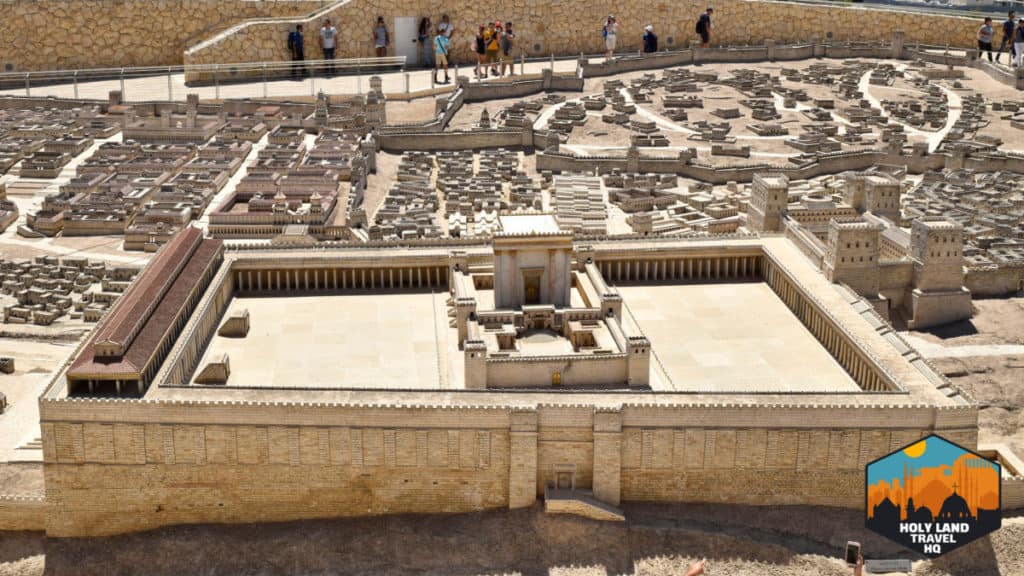
As you can see, the temple was just as impressive as the mount it sat on. But it isn’t an exact replica. It’s more of an educated guess.
How did the Western Wall become a thing?
Not much is known about the Temple Mount between 70 CE and the middle ages. We can see by looking at the Western Wall that there are three layers of history though.
Large Herodian style stones, with their dressed edges, make up the bottom layer. The middle layer is made up of slightly smaller, block style stones dating back to the Islamic, Umayyad dynasty. The top layer of small stones is from later Islamic periods.
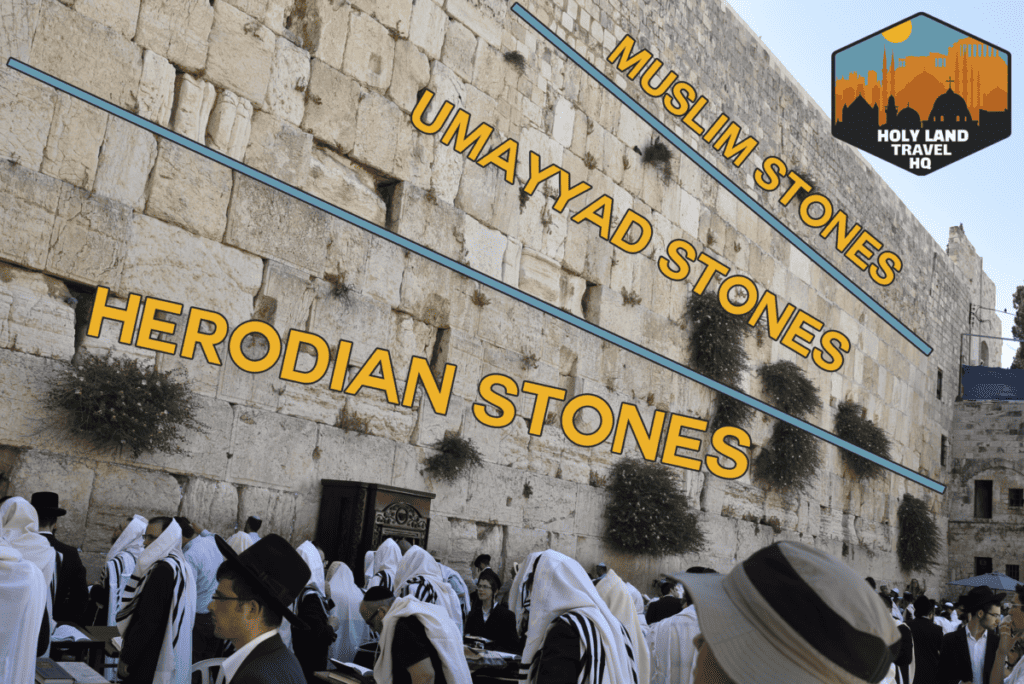
Jews have been worshiping at the Temple Mount and Western Wall for centuries. As early as the 11th Century, historians know Jewish travelers would circle the mount and pray.
In the 16th century Ottoman Sultan, Suleiman the Magnificent began a restoration project of the walls. The top layer of small stone blocks was most likely part of this restoration. Suleiman also issued a decree that Jews could pray at the Western Wall. (Reference from Middle East Quarterly)
Pictures from the early 20th century show the area in front of the Western Wall covered with housing. A narrow alley is all the existed to allow Jewish visitors access to the Wall for prayer.
In 1948, the modern state of Israel was established; however, the Temple Mount and Old City was still under Jordanian rule. After the Arab-Israeli war in the same year, Jordan prohibited Jewish access to the area.
In 1967, a 6-day war between Israel and Jordan ensued in which Israel pushed Jordan out. After the conflict, Israel leveled the Moroccan Quarter, the Arab neighborhood in front of the Western Wall. This sparked political controversy and has been a sticking point in the Israeli-Palestinian conflict ever since.
Why don’t we know much about the history of the Western Wall?
Today, the Herodian Temple mount only serves as the foundation for the modern site. Because the slabs and foundation stones are so massive, they’ve survived the test of time. However, the site as a whole is layer upon layer of history archaeologists have only scratched the surface on.
The northwest side of the Temple Mount sits under the modern Old-City of Jerusalem. The top and internal space of the structure is currently under Islamic control.
The Western Wall tunnels were discovered in the 19th century by British archaeologists. It wasn’t until 1996 that excavations restarted. With the modern city sitting on top of the ruins as well as the Arab occupation of the mount itself, there is still much to be found.
The Jerusalem Islamic Waqf, the Islamic trust that controls the Temple Mount complained about the excavations for various reasons. Primarily that it was an Israeli attempt to get into the Temple Mount.
That same year, the Waqf began demolition inside the Temple Mount themselves. They used bulldozers and heavy equipment to clear out the area in order to construct a large prayer space.
After many court battles and legal issues, the construction was halted. But not after a large mound of debris was formed on the eastern side of the Temple Mount.
In 2005, the Temple Mount Sifting Project began. Primarily supported through crowd-sourcing, most of the artifacts recovered are ostraca or shards of pottery. About 15% of these artifacts go as far back as the Iron Age, which is the First Temple Period.
Why is the Western Wall also called the Wailing Wall?
The Western Wall is called the Wailing Wall because of the Jewish practice of weeping to mourn the destruction of the temple. As well as the temple’s current political disposition and the effect that the destruction has had on the national identity of the Hebrew people.
Within modern Jewish culture, the Western Wall is only called the Western Wall. Or by its Hebrew name, the Kotel. Only non-Jews call it the Wailing Wall.
How to Visit the Western Wall.
It is free to visit the Western Wall. It’s actually considered to be an outdoor synagogue, so there is no price of admission.
There are 2 main entrances. The largest one is to the south and can accommodate large crowds and vehicles. It’s the easiest entrance for tourists with disabilities as well.
Another entrance is on the west, opposite the wall across the courtyard. It’s a single line entrance and welcomes visitors coming from the Jewish Quarter.
Both entrances require visitors to proceed through a metal detector. Purses and backpacks are allowed into the Western Wall courtyard. So are cameras.
All bags will be searched. It will be quick though. When interacting with Israeli security, be calm. Remember, they have a job to do, and inspecting you is part of it. The easier you make that job for them, the better it is for everyone. Be prepared with your bag open.
Men must wear a hat in the synagogue designated area. If you don’t have one, you can borrow or take one from the bin of yamakas at the entrance to the men’s area.
Women have an area sperate from the men. Some tour groups advertise that women must cover their shoulders and legs when entering the women’s prayer area.
Generally, appropriate attire is required for everyone. I’ve worn shorts there before and have seen several other tourists wear shorts. I’ve also seen women wear shorts, but its good practice to have a shawl or waist wrap handy just in case.
Conduct that will bring attention to you are: smoking, eating, lighting candles when not part of an event, wearing offensive t-shirts, and taking pictures on the Sabbath. You can take pictures the rest of the time, though.
What’s the deal with the prayer notes in the wall?
At the wall, you’ll see small pieces of paper jammed into the cracks and gaps between the stones. These are prayers. People will write prayers down on small pieces of paper and then embed them in the wall.
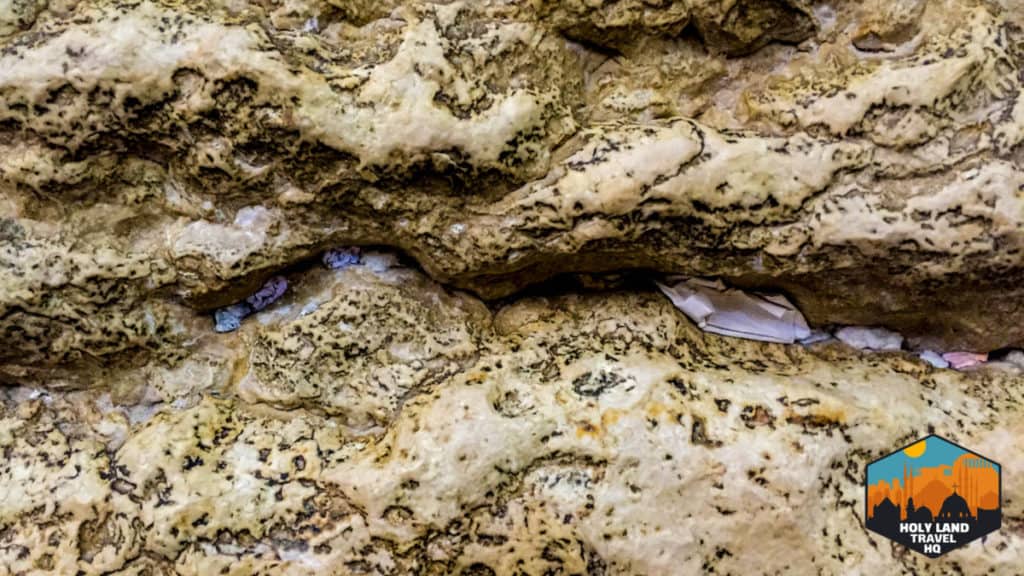
Once a year, the Western Wall Heritage Foundation (direct link) removes the prayer notes. The pieces of paper are thought of in the same manner as a scroll which needs to be retired. The foundation takes the notes to a designated location on the Mount of Olives to bury them.
Feel free to leave a prayer note. There is no procedure, limit, or mandated paper size. Any piece of paper will do, though I recommend making it small. I’ve left prayer notes for myself and once my brother sent me a prayer that I wrote out and placed for him.
The practice of leaving prayer notes in the wall is not something reserved for physical visits. If you are unable to make it to the Holy Land, you can have a prayer note placed for you.
Go to the Western Wall Heritage Foundation website and fill out the form (link form). A prayer note will be placed in the wall on your behalf with the pray you entered in the form.
What will you find in the Western Wall Underground?
The Western Wall Underground is open for public tours. The entrance is located inside the controlled area of the Western Wall. You have to schedule your tour on the Western Wall Heritage Foundation website. You cannot show up when you want to.
The Western Wall is the closest synagogue to where the Hebrew Temple once stood. However, the nearest near point one can get has been determined to be in the Underground.
If you take the tour, you will see Jews praying along the wall at that point. Unlike the prayer area at the street level, the underground prayer area does not separate men and women. Feel free to stop on your way back out.
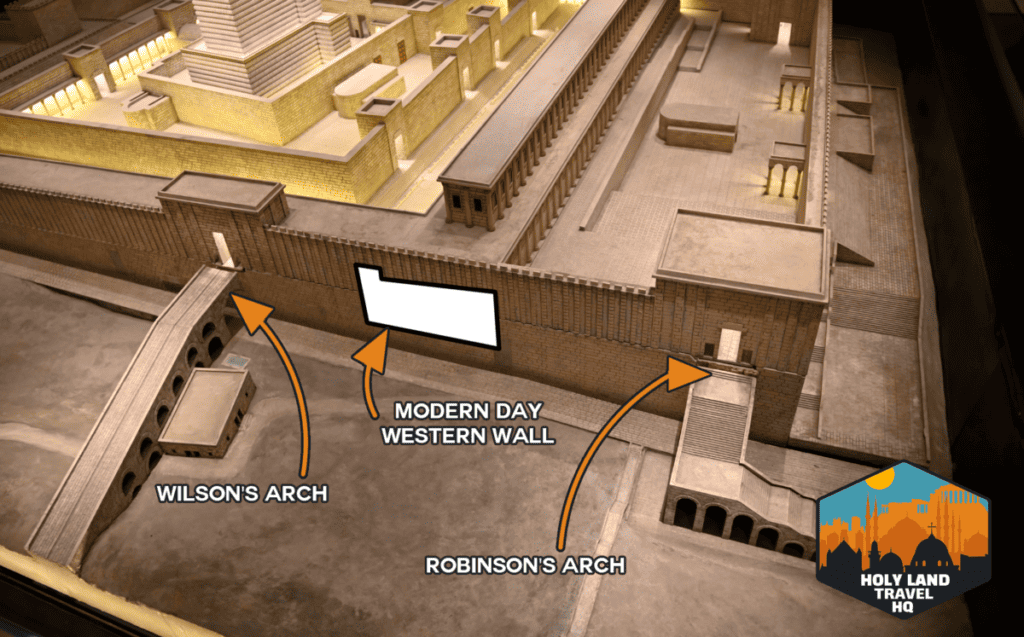
The tour itself is fascinating. The picture above is from a model you’ll find on the Great Bridge Route Tour. This is what archaeologists think the Temple Mount looked like in the first century. The white overlay is the portion of the wall that is the Western Wall today.
Like I stated earlier, one of the 500-ton foundation slabs found by archaeologists is also on the underground tour. It is a massive sight to see. You can’t miss it.
The original sidewalk has also been discovered, and you will actually walk on it as the tour progresses. This is a sidewalk Jesus potentially walked on. So, don’t simply walk over it without reflecting for a moment about the history its seen.
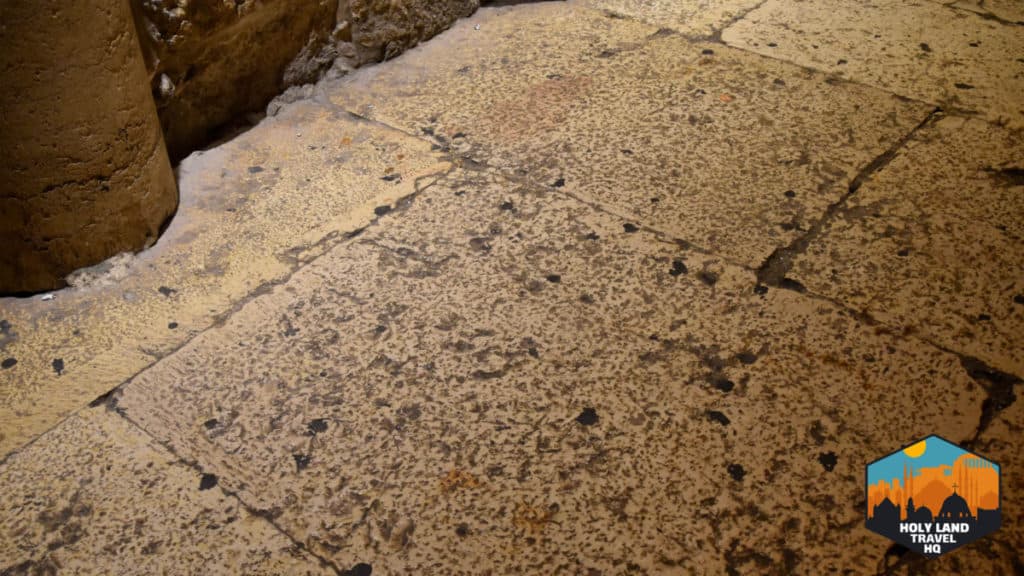
If you are wondering how the ancients built large stone structures to stay standing, your tour guide will provide an interesting answer. Each layer of stone block was cut 2cm shorter in length and width. So, as the temple walls rose in height, the wall angled inward. This forced the center of gravity of the walls to trend towards the structure of the temple mount.
If your tour group does not take the tour, you can sign up for the tour on your own. The tour is called the Western Wall Tunnels. You can sign up as a group or individual. For more information, click here.
What else you will see at the Western Wall.
In Jewish religious culture, at the age of 13, believers are considered old enough to begin observing and taking part in religious worship. Jews celebrate this milestone with a Bar Mitzvah for boys or a Bat Mitzvah for girls.
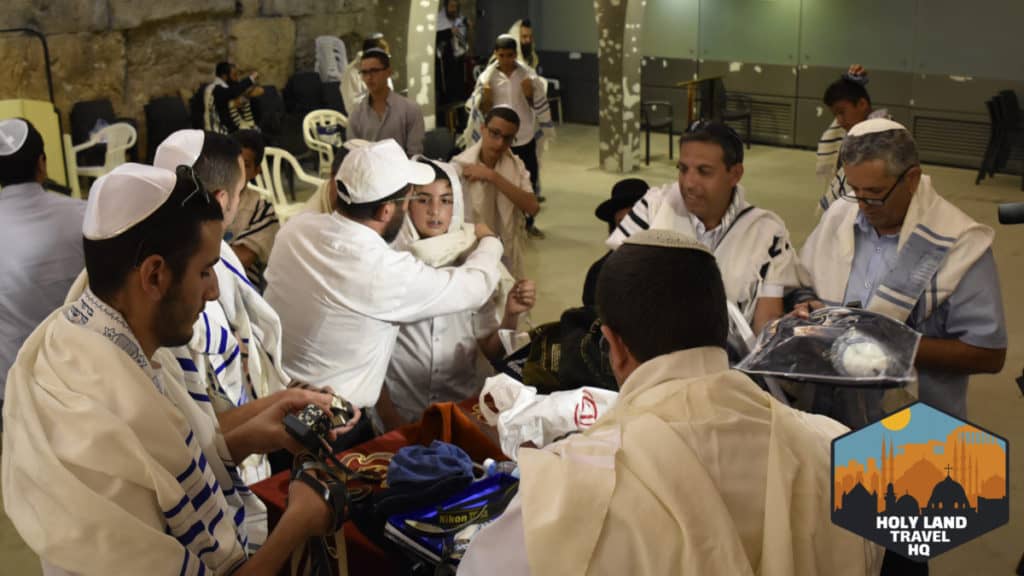
By: Holy Land Travel HQ
When you visit the Western Wall, you will most likely witness several of these events happening. The Western Wall Heritage Foundation requires celebrants to register to conduct the events. Some of them are larger than others and registration is a way to control the crowd.
There are no restrictions on watching or taking pictures. Though I would refrain from participating. Be an observer and take it all in.
An interesting aspect of this is when female relatives go to the women’s side and stand on chairs along the barrier. They’ll peer over the fence to view their son or brother’s bar mitzvah. Men do the same for their daughters and sisters.
Things to be aware of.
Occasionally you might get approached by a Hasidic Jew asking for money. They can sometimes be rather forceful and even pushy. There are no entrance fees to the Western Wall. Nor are there any requirements to give to a cause.
Hasidic Jews are the part of the population that wear the traditional Jewish garments. They generally stick to themselves, are polite, and do their thing. However, there are portions of that population that feel a sense of entitlement and cause problems. Usually not at the Western Wall, but sometimes.
If you get asked for money or to donate to them, you are not obligated to do so. Simply tell them ‘no, thanks,’ and they will go away. If ‘no’ is not enough for you, use this phrase: “Thank you for your request. I plan to donate through official organizations.”
If a Hasidic Jew gets pushy, or won’t leave you alone, just leave. If it’s bad, report it to security. Such behavior is not allowed inside, or outside the Western Wall.


